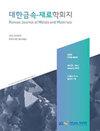A Review of Recent Research Trends of Forming of Metallic Bondlines Using Core-Shell Particles and Bonding Properties According to Particle Type
IF 1.1
4区 材料科学
Q4 MATERIALS SCIENCE, MULTIDISCIPLINARY
引用次数: 0
Abstract
With the increasing numbers of electric vehicles and the prevalence of high heat generating devices, recent studies have attempted to address the limitations of conventional solder materials, including their low durability at temperatures exceeding 200 ℃, insufficient mechanical properties in a joint, and low thermal conductivity. Transient liquid-phase (TLP) partial bonding using solders or Sn, and sinter bonding using Ag particles, are alternative bonding methods which involve a modification or change of the material. Advanced alternatives can significantly reduce bonding time or material cost. Various additional studies have investigated various core-cell particles that can be used to form an all-metallic bondline. This review summarizes reports of bonding studies using different core-cell particles. The particles were not only applied as a form of paste but also preform. In the TLP bonding using X(Cu, Ag, Ni)@Sn particles, the degree of voids generated in the formed bondline was dependent on the type of intermetallic compound formed. The preforms consisting of X@Sn particles provided relatively uniform microstructure and void distribution, compared to the pastes containing identical X@Sn particles, resulting in better long-term mechanical reliability. The addition of Zn@Sn particles contributed to the more practical control of microstructure and mechanical properties in the joint formed by pure Sn and Sn-58Bi solder alloys. Cu@Ag particles can be considered a promising low-cost material for compression-assisted sinter bonding, replacing pure Ag particles. The application of core-cell particles is expected to improve the processes used for forming metallic bondlines.用核壳粒子形成金属键线的研究进展及按粒子类型划分的键合性能
随着电动汽车数量的增加和高发热器件的普及,最近的研究试图解决传统焊接材料的局限性,包括其在超过200℃的温度下的低耐久性、接头的机械性能不足以及低导热性。使用焊料或Sn的瞬态液相(TLP)部分结合和使用Ag颗粒的烧结结合是涉及材料改性或改变的替代结合方法。先进的替代品可以显著减少粘合时间或材料成本。各种额外的研究已经研究了可用于形成全金属结合线的各种核心细胞颗粒。这篇综述总结了使用不同核心细胞颗粒进行结合研究的报告。颗粒不仅以糊状物的形式施加,而且还以预成型体的形式施加。在使用X(Cu,Ag,Ni)@Sn颗粒的TLP接合中,在所形成的接合线中产生的空隙程度取决于所形成的金属间化合物的类型。与含有相同X@Sn颗粒的浆料相比,由X@Sn粒子组成的预成型体提供了相对均匀的微观结构和空隙分布,从而产生了更好的长期机械可靠性。添加Zn@Sn颗粒有助于更实际地控制由纯Sn和Sn-58Bi焊料合金形成的接头中的微观结构和机械性能。Cu@Ag颗粒可以被认为是一种很有前途的低成本材料,用于压缩辅助烧结结合,取代纯Ag颗粒。核心电池颗粒的应用有望改善用于形成金属结合线的工艺。
本文章由计算机程序翻译,如有差异,请以英文原文为准。
求助全文
约1分钟内获得全文
求助全文
来源期刊

Korean Journal of Metals and Materials
MATERIALS SCIENCE, MULTIDISCIPLINARY-METALLURGY & METALLURGICAL ENGINEERING
CiteScore
1.80
自引率
58.30%
发文量
100
审稿时长
4-8 weeks
期刊介绍:
The Korean Journal of Metals and Materials is a representative Korean-language journal of the Korean Institute of Metals and Materials (KIM); it publishes domestic and foreign academic papers related to metals and materials, in abroad range of fields from metals and materials to nano-materials, biomaterials, functional materials, energy materials, and new materials, and its official ISO designation is Korean J. Met. Mater.
 求助内容:
求助内容: 应助结果提醒方式:
应助结果提醒方式:


